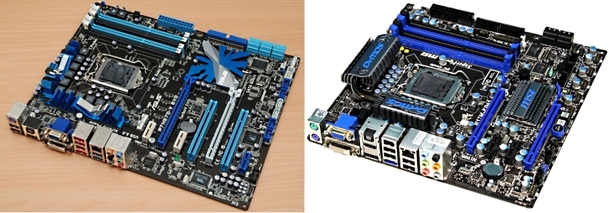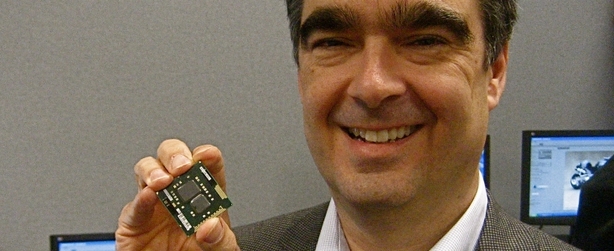Integrated GPU
While we usually expect to see manufacturing processes shrink as time goes on, due to the intrinsic benefits smaller transistors bring - lower power consumption, more dies per wafer, higher maximum frequencies - this time, the drop in process has enabled Intel to squeeze in an integrated GPU. As with its Core 2 Quad CPUs, Intel hasn't bothered to go through the R&D hell of trying to integrate everything into one die – the CPU and GPU two dies are visibly separated inside the CPU package.This has also meant that Intel didn’t need to bother shrinking the GPU’s manufacturing process. While the CPU has all the benefits of 32nm transistors, the GPU is made on the more mundane (these days, at least) 45nm process. The two chips are linked within the CPU package by an internal QPI link, so the CPU and GPU are integrated for all practical purposes – the CPU can fetch work from memory and hand it to the GPU, which can output to your screen, and all without bothering the rest of the system (at least, on motherboards with H55, H57 or Q57 chipsets).
The GPU Intel has chosen has some interesting, but fairly limited uses. For a start, it’s an evolution of the dire GMA series that gamers hate with a passion. It’s a new GPU and yet only supports DirectX 10 – not even DirectX 10.1 - for heaven's sake. Intel claims this is because "there are no other integrated DirectX 10.1 products on the market either", but given that DirectX 11 is just around the corner for mobile products elsewhere, we can't but help this is yet another poor excuse from the Intel graphics department.
At the moment, the integrated GPU is switched off when you plug in a graphics card, but because the "uncore" die also contains the PCI-Express and memory controller, it's not disabled entirely. On the mobile parts, the GMA graphics also TurboBoost as well between 133MHz and 500MHz, and the CPU-GPU trade thermal budget depending on the load to both. The desktop parts are locked to their full speed 733MHz, or the 661, which is 900MHz.
The GMA HD chip is really only present for non-gaming applications – we'll explore these uses more in a later article now that we're all back in the office following our Christmas break.
Intel acknowledges this however, and on the mobile front it has worked with Nvidia and AMD in designing an on-the-fly switchable graphics platform for upcoming mobile products.

The first motherboards we've seen to support the new CPU's GPU: left, the Asus P7H57D-V EVO; right: the MSI H57M-ED65.
While DXVA (DirectX Video Acceleration) and the possibility of tiny yet powerful PCs are all very well, it’s the future possibilities of what GPU integration might mean that are the most intriguing. In addition there is also dual digital output support from Intel's latest GMA graphics too, with Intel claiming the design was specifically for HDMI and DisplayPort, but standard DVI can also be used - note there's no dual-link option though and 2560x1600 is only available via DisplayPort. There's support for DTS MasterHD and Dolby TrueHD audio streams over HDMI thanks to the HDMI 1.3a, and even 24Hz support too, making these practically perfect for a HTPC.
Nvidia is very keen to downplay the importance of the CPU at the moment, claiming that the GPU is such a powerful, general-purpose co-processor that you only need a puny CPU. While you’d expect exactly that rhetoric from a company that makes GPUs and not CPUs (discounting Tegra, which licenses an ARM core), AMD and Intel itself are also hinting that GPUs will be used for general processing more and more in the future. Intel does have a DirectCompute driver for Windows 7 and its GMA graphics in development, but it won't be available until later this year.

Underneath the heatspreader of the Core i5 and Core i3 - the GPU is separate to the CPU, as you can see.
AMD announced its plans for a Fusion CPU that incorporated a GPU in July 2007, and many saw the acquisition of graphics company ATI as a significant step towards that product. However, the first AMD Fusion processor, codenamed Bulldozer, isn’t due till 2011. Meanwhile, there’s the rise of GPGPU (General Purpose GPU) applications such as folding@home, GPU acceleration for Flash 10.1 and parts of Adobe CS 4, plus Nvidia’s array of CUDA-based applications such as BaDaBoom.
Even Intel’s troubled GPU project Larrabee was seen by many to be more a stab at getting into the GPGPU market than as a serious attempt at a gaming graphics processor due to its x86-based architecture. Whether we’ll see integrated GPUs ever act in the same way as maths co-processors used to back in the ‘good’ old days isn’t yet clear, but it certainly seems that the big players in IT are moving in that direction.

MSI MPG Velox 100R Chassis Review
October 14 2021 | 15:04









Want to comment? Please log in.